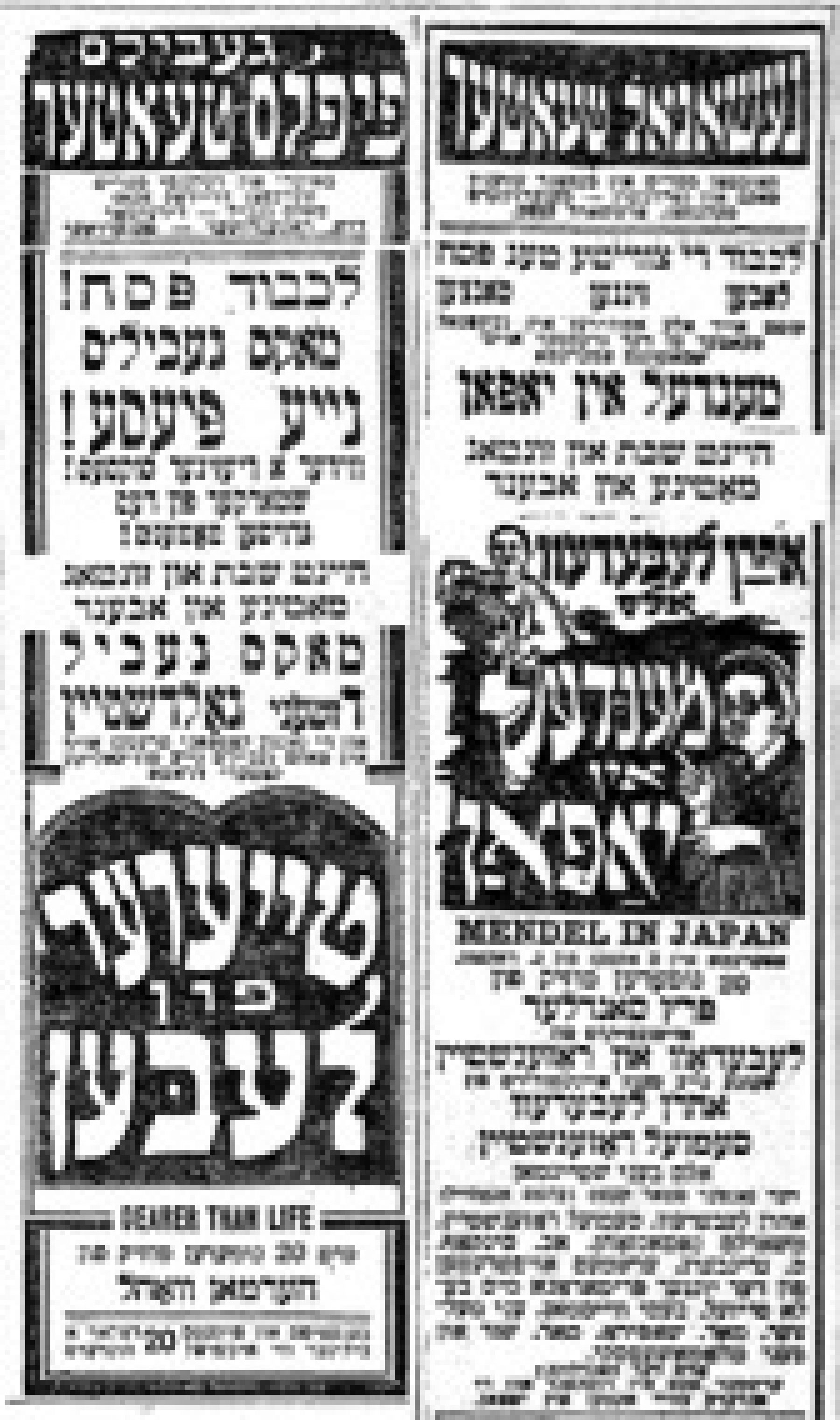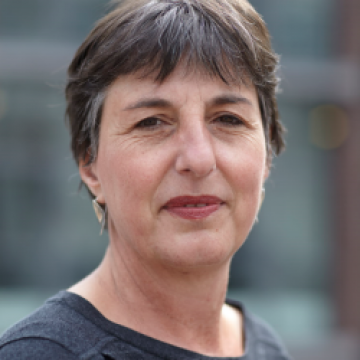
Pesach advertisements of the National Theatre and Gabel’s People’s Theatre, Forward April 26, 1924.
Lekoved pesach
Judith Thissen
It was in 1910 that the Yidishes tageblatt (Jewish Daily News) observed, with some dismay, “Where other nationalities spend the bulk of their money at weddings, funerals and processions, the Jew has his Passover, which makes a hole in his pocket every year.” Adapting to the abundance of the New World, Passover developed into a secular festival for shopping and entertainment. Street peddlers and stores in Jewish neighborhoods enjoyed one of the busiest shopping periods in the year, as immigrants adapted to the abundance of the New World. They not only bought special foods and new kitchenware, but also new furniture and clothes, inspired by full-page advertisements in the Yiddish newspapers. “I know I was wasting money,” Sadie, a young “ghetto girl” confessed to the New York Times after she had bought an expensive hat in the latest fashion, “but you must be in style for Easter.” All dressed up in brand-new clothes, she might have gone, like many other immigrants, to the Bowery or Second Avenue to see one of the new plays and classics that were programmed in honor of Pesach.

Pesach advertisements of the National Theatre and Gabel’s People’s Theatre, Forward April 26, 1924.
The tradition of going out in celebration of a religious holiday started in the 1890s with the growing popularity of the Yiddish theatre. In particular, Sukkoth and Pesach developed into widely-advertised theatrical events, marking the beginning and the end of the high season in the Yiddish theatre district. After a pre-season with classics and the latest “serious” plays in the realist tradition, new melodramas with high box-office potential premiered during the week of Sukkoth, supported by extensive advertising in the Yiddish press. On the first and last two days of the festival, thousands of theatre fans flocked to the Yiddish theatres for the special matinee and evening performances promoted lekoved sukes - in honor of Sukkoth. The high season ended at Passover, for which the playhouses again programmed additional performances. Lekoved peysekh, the star-managers billed the best they had to offer to please the holiday crowds before they closed their doors for the summer and left the city to tour the “provinces.” Audiences could select from a wide range of plays as each company staged the highlights of its repertoire during the extra matinee shows, while the evening performances were reserved for the latest box-office hit or a new “peysekh-dige” production.
Yiddish vaudeville houses copied their legitimate theatre counterparts and also advertised special programs and guest performances. On April 29, 1910, Di yidishe bihne (The Yiddish Stage) boasted that at the Golden Rule Theatre, on 125 Rivington Street, would stage “In honor of Pesach something new, the pride of all vaudeville.” In this same issue, the Golden Rule’s competitor, the Grand Music Hall, told prospective patrons: “Don’t miss our program! Come to greet our two guests Miss Annie Blok and Miss Annie Ernst.” Even film exhibitors joined in and capitalized on the festival. When available, they programmed Jewish-themed films or biblical movies suited to the holiday. The Life of Moses (Vitagraph, 1909), Joseph in the Land of Egypt (Thanhouser, 1914) and Joseph’s Trials in Egypt (Pathé, 1914) were Passover blockbusters. Cecil B. DeMille’s silent epic The Ten Commandments (Paramount, 1923) was a success, too.
In the 1910s, the tradition of going out to the theatre or movies on Pesach moved uptown as the second generation discovered Broadway shows. This habit became so popular that managers of movie palaces and leading Broadway theatres took note of the holiday and began to program additional matinee shows, for which they advertised in the Yiddish press. The positive impact of Passover was on box office takings was particularly keenly felt when the holiday overlapped with the Christian Holy Week, which negatively influenced box-office figures. “Hebrew Holidays Proved Big Help During Holy Week,” summarized a lead article in Variety about business earnings in New York in early April 1915. By the 1920s, Pesach had become booming business for the uptown theatre district as well as for upscale vaudeville houses and movie palaces in middle-class suburbs in Brooklyn, Queens, and the Bronx. An incident reported by Variety gives us further insight in the importance of the “Passover crowds.” In 1922, acting on a request by the priest of a church frequented by actors, the Keith and Moss chain agreed to give no performances in its New York vaudeville houses on Good Friday between the hours of noon and 3 PM, which Christians consider those of Jesus’s agony on the cross. However, when the management realized that this particular Friday was also the second day of Passover, Keith and Moss abandoned the plan because “it would have complicated matters in Greater New York where thousands of Jewish vaudeville patrons are of Jewish faith.”
The Yiddish playhouses seem not to have suffered much from the trend among the young of celebrating Pesach uptown, a sign of the ongoing acculturation and integration into the mainstream. Even when legislation sharply reduced the influx of new immigrants from eastern Europe, the holiday habit was kept alive by the older generations. In the US, going out to see a Yiddish show with relatives or friends belonged to the rituals of Pesach as much as the traditional Seder meal. Well into the late 1920s, the spring festival remained one of the few moments during the theatrical season when Yiddish theatre managers did not have to worry about box-office and could enjoy the lively business of the good old days.
